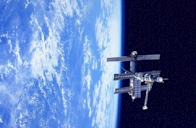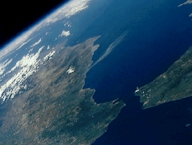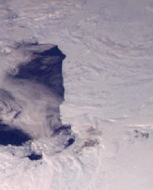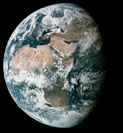THE EARTH
Earth is the only planet whose English name does not derive from Greek or Roman mythology. The name comes from Old English and Germanic language. There are, of course, hundreds of other names for the planet in other languages.
This is the symbol for Earth: ![]()
Earth is the third planet from the Sun, and the fifth largest of the nine planets.
 Earth, of course, can be studied without the aid of spacecraft. It was not until the twentieth century that we had maps of the entire planet. Pictures of our planet taken from space are very important! They are a big help in predicting the weather - especially in tracking and predicting hurricanes. They are also extraordinarily beautiful. Earth, of course, can be studied without the aid of spacecraft. It was not until the twentieth century that we had maps of the entire planet. Pictures of our planet taken from space are very important! They are a big help in predicting the weather - especially in tracking and predicting hurricanes. They are also extraordinarily beautiful. |
| The Earth’s surface is very young. This means that the Earth’s surface has changed a lot from when it was first formed. Erosion and tectonic processes (like earthquakes) destroy, recreate and reshape most of the Earth’s surface. |  |
 71 % of the Earth’s surface is covered with water. Earth is the only planet on which water can exist in liquid form on the surface. Water is essential for life as we know it. The Earth’s vast oceans keep temperatures stable - important for life on our planet. Water is also responsible for most of the erosion and weathering of the Earth’s continents, a process unique in our solar system. 71 % of the Earth’s surface is covered with water. Earth is the only planet on which water can exist in liquid form on the surface. Water is essential for life as we know it. The Earth’s vast oceans keep temperatures stable - important for life on our planet. Water is also responsible for most of the erosion and weathering of the Earth’s continents, a process unique in our solar system. |
| The Earth’s atmosphere is 77% nitrogen, 21% oxygen, with traces of argon, carbon dioxide and water. The carbon dioxide in the Earth’s atmosphere is very important. Carbon dioxide helps to maintain the Earth’s temperature by way of the "Greenhouse Effect." The Greenhouse Effect warms the Earth’s temperature; without it, the oceans would freeze and life as we know it would be impossible. |  |
 | Besides being the most interesting and unique of all the planets, our Earth is also the most beautiful. From space, the Earth’s white clouds, blue oceans and brown lands seem to shine against the black backdrop of our solar system. |
![]()
| ~ | Earth is a small, rocky planet which supports a variety of life! As far as we know, Earth is unique from all other planets in this respect. |
| ~ | Temperatures at the Earth’s center (called the "core") may be as high as 7500 K - That’s hotter than the surface of the Sun! |
| ~ | The Earth is the densest major body in the solar system. This means that it’s the most "compact" of all the planets. For example, you have two loaves of bread, both of the same amount. You smash one loaf of bread flat. Even though both loaves are of the same amount, the smashed bread is *denser* because it is more compact. |
| ~ | The Earth is 4.5 to 4.6 billion years old, but the oldest known rocks are less than 4 billion years old. Rocks older than 3 billion years are rare. The oldest fossils of living organisms are less than 3.9 billion years old! |
| ~ | The Earth is orbited by one moon. |
Earth is the third planet from the Sun, and the fifth largest of the nine planets.
 Earth, of course, can be studied without the aid of spacecraft. It was not until the twentieth century that we had maps of the entire planet. Pictures of our planet taken from space are very important! They are a big help in predicting the weather - especially in tracking and predicting hurricanes. They are also extraordinarily beautiful. Earth, of course, can be studied without the aid of spacecraft. It was not until the twentieth century that we had maps of the entire planet. Pictures of our planet taken from space are very important! They are a big help in predicting the weather - especially in tracking and predicting hurricanes. They are also extraordinarily beautiful. |
| The Earth’s surface is very young. This means that the Earth’s surface has changed a lot from when it was first formed. Erosion and tectonic processes (like earthquakes) destroy, recreate and reshape most of the Earth’s surface. |  |
 71 % of the Earth’s surface is covered with water. Earth is the only planet on which water can exist in liquid form on the surface. Water is essential for life as we know it. The Earth’s vast oceans keep temperatures stable - important for life on our planet. Water is also responsible for most of the erosion and weathering of the Earth’s continents, a process unique in our solar system. 71 % of the Earth’s surface is covered with water. Earth is the only planet on which water can exist in liquid form on the surface. Water is essential for life as we know it. The Earth’s vast oceans keep temperatures stable - important for life on our planet. Water is also responsible for most of the erosion and weathering of the Earth’s continents, a process unique in our solar system. |
| The Earth’s atmosphere is 77% nitrogen, 21% oxygen, with traces of argon, carbon dioxide and water. The carbon dioxide in the Earth’s atmosphere is very important. Carbon dioxide helps to maintain the Earth’s temperature by way of the "Greenhouse Effect." The Greenhouse Effect warms the Earth’s temperature; without it, the oceans would freeze and life as we know it would be impossible. |  |
 | Besides being the most interesting and unique of all the planets, our Earth is also the most beautiful. From space, the Earth’s white clouds, blue oceans and brown lands seem to shine against the black backdrop of our solar system. |
 | Click here to visit the Moon! |
Earth is the third planet from the Sun, and the fifth largest of the nine planets.
 Earth, of course, can be studied without the aid of spacecraft. It was not until the twentieth century that we had maps of the entire planet. Pictures of our planet taken from space are very important! They are a big help in predicting the weather - especially in tracking and predicting hurricanes. They are also extraordinarily beautiful. Earth, of course, can be studied without the aid of spacecraft. It was not until the twentieth century that we had maps of the entire planet. Pictures of our planet taken from space are very important! They are a big help in predicting the weather - especially in tracking and predicting hurricanes. They are also extraordinarily beautiful. |
| The Earth’s surface is very young. This means that the Earth’s surface has changed a lot from when it was first formed. Erosion and tectonic processes (like earthquakes) destroy, recreate and reshape most of the Earth’s surface. |  |
 71 % of the Earth’s surface is covered with water. Earth is the only planet on which water can exist in liquid form on the surface. Water is essential for life as we know it. The Earth’s vast oceans keep temperatures stable - important for life on our planet. Water is also responsible for most of the erosion and weathering of the Earth’s continents, a process unique in our solar system. 71 % of the Earth’s surface is covered with water. Earth is the only planet on which water can exist in liquid form on the surface. Water is essential for life as we know it. The Earth’s vast oceans keep temperatures stable - important for life on our planet. Water is also responsible for most of the erosion and weathering of the Earth’s continents, a process unique in our solar system. |
| The Earth’s atmosphere is 77% nitrogen, 21% oxygen, with traces of argon, carbon dioxide and water. The carbon dioxide in the Earth’s atmosphere is very important. Carbon dioxide helps to maintain the Earth’s temperature by way of the "Greenhouse Effect." The Greenhouse Effect warms the Earth’s temperature; without it, the oceans would freeze and life as we know it would be impossible. |  |
 | Besides being the most interesting and unique of all the planets, our Earth is also the most beautiful. From space, the Earth’s white clouds, blue oceans and brown lands seem to shine against the black backdrop of our solar system. |
 | Click here to visit the Moon! |
Earth is the third planet from the Sun, and the fifth largest of the nine planets.
 Earth, of course, can be studied without the aid of spacecraft. It was not until the twentieth century that we had maps of the entire planet. Pictures of our planet taken from space are very important! They are a big help in predicting the weather - especially in tracking and predicting hurricanes. They are also extraordinarily beautiful. Earth, of course, can be studied without the aid of spacecraft. It was not until the twentieth century that we had maps of the entire planet. Pictures of our planet taken from space are very important! They are a big help in predicting the weather - especially in tracking and predicting hurricanes. They are also extraordinarily beautiful. |
| The Earth’s surface is very young. This means that the Earth’s surface has changed a lot from when it was first formed. Erosion and tectonic processes (like earthquakes) destroy, recreate and reshape most of the Earth’s surface. |  |
 71 % of the Earth’s surface is covered with water. Earth is the only planet on which water can exist in liquid form on the surface. Water is essential for life as we know it. The Earth’s vast oceans keep temperatures stable - important for life on our planet. Water is also responsible for most of the erosion and weathering of the Earth’s continents, a process unique in our solar system. 71 % of the Earth’s surface is covered with water. Earth is the only planet on which water can exist in liquid form on the surface. Water is essential for life as we know it. The Earth’s vast oceans keep temperatures stable - important for life on our planet. Water is also responsible for most of the erosion and weathering of the Earth’s continents, a process unique in our solar system. |
| The Earth’s atmosphere is 77% nitrogen, 21% oxygen, with traces of argon, carbon dioxide and water. The carbon dioxide in the Earth’s atmosphere is very important. Carbon dioxide helps to maintain the Earth’s temperature by way of the "Greenhouse Effect." The Greenhouse Effect warms the Earth’s temperature; without it, the oceans would freeze and life as we know it would be impossible. |  |
 | Besides being the most interesting and unique of all the planets, our Earth is also the most beautiful. From space, the Earth’s white clouds, blue oceans and brown lands seem to shine against the black backdrop of our solar system. |
 | Click here to visit the Moon! |
0 comentarios